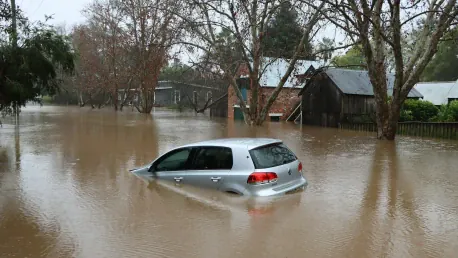The year 2024 has marked a significant turning point for Canada, ushering in an era defined by record-breaking financial losses due to natural disasters. Canada has experienced over $7.6 billion in catastrophic damages, all driven by severe weather events such as storms, floods, and wildfires. This unprecedented figure, sourced from an Aon plc. report, marks a dramatic increase, effectively doubling the losses recorded in the previous year. Experts attribute this surge to the escalating intensity and frequency of these disastrous events, which are largely driven by climate change. The financial strain on the insurance industry is becoming untenable, threatening not only the affordability of insurance but also the broader stability of the housing and financial markets in Canada.
Escalating Intensity of Natural Disasters
The unprecedented losses in 2024 can be traced to several critical catastrophic events that have struck different regions in Canada. A devastating hailstorm in Calgary, widespread flooding in Quebec and Ontario, a catastrophic wildfire in Jasper, Alberta, and severe winter storms across British Columbia, Alberta, and Saskatchewan have cumulatively set new records for annual losses. These calamities have sadly outpaced the infamous 2016 Fort McMurray wildfire, which was previously one of the most costly disasters in Canada’s history. Such events underscore the growing severity and increased frequency of natural disasters in Canada.
Craig Stewart, vice-president for climate change and federal issues at the Insurance Bureau of Canada, emphasizes the increasing intensity of these devastating occurrences. He directly links this sharp rise to climate change, urging that it must be recognized as a substantial contributing factor to these natural disasters. Stewart argues that this acknowledgment is no longer just an environmental concern but has become a pressing financial issue that Canada must address. As these catastrophic weather events become more frequent, their financial impact continues to grow, demanding immediate and comprehensive action from policymakers, insurance companies, and the general public.
Surging Homeowner Insurance Costs
One of the most significant consequences of these heightened risks is the exponential increase in homeowner insurance costs. Since 2002, insurance premiums have surged nearly 350 percent by 2024, far outpacing all other housing-related expenses. Alister Campbell, a former insurance executive, identifies the primary culprits behind these rising costs as climate change and expanding urban areas, both of which compound exposure to natural disasters and escalate claims. This surge in premiums has rendered Canada the nation with the highest property insurance costs among wealthy countries. Contrary to popular belief, these increases are not due to higher profits for insurance companies but are a direct result of the increased losses they must cover.
Families and individuals across Canada are bearing the financial brunt, raising serious concerns about the affordability and sustainability of insurance amid escalating risks. As risks grow, insurers are pushed to adjust their pricing models to account for the increased likelihood of payouts. However, this approach also means that many Canadians, especially those living in high-risk areas, face soaring premiums that threaten their ability to insure their homes adequately. The situation is becoming untenable, with a pressing need for innovative solutions to balance risk management and affordability.
Lack of Federal Partnership and Its Impact
A major issue exacerbating the insurance crisis is the lack of a federal government partnership to help shoulder the costs associated with catastrophic events. Unlike other wealthy nations that have robust systems in place for sharing these burdens, Canada’s approach leaves homeowners and the insurance industry to manage the full financial impact alone. This absence of federal collaboration is particularly burdensome for those in high-risk areas prone to floods, fires, and storms. Rising insurance premiums are already threatening affordability and access, and the problem may worsen as re-insurers adjust their thresholds, placing additional strain on smaller insurance companies and homeowners.
The necessity for a more collaborative approach between the government and the insurance industry is increasingly evident. A sustainable solution to managing catastrophic risks requires the development of a comprehensive partnership that could help distribute financial burdens more equitably. Federal intervention could also facilitate the creation of safety nets or relief funds, ensuring that those most affected by natural disasters receive timely and adequate support. This kind of partnership would not only alleviate immediate financial strain but also contribute to long-term resilience against future catastrophic events.
Insufficiency in Data and Risk Models
A critical challenge facing the insurance industry is the inadequacy of data on the private sector’s exposure to climate risks. The Bank of Canada has flagged this concern, pointing out the insufficient information available to gauge the true financial risks posed by climate change. A report from January 2024 highlighted the potentially devastating economic consequences of a significant flood event, particularly for households lacking adequate insurance coverage. The deficiency in reliable data affects the accuracy of risk models, which are crucial for assessing and pricing insurance products effectively.
Historical failures, such as the poor prediction of the Fort McMurray wildfires, underscore the need for more precise and up-to-date risk models that can reflect new scientific insights and past disaster impacts. Updating these risk models is vital for the accurate assessment and pricing of insurance products. As climate change continues to alter weather patterns and increase the frequency of natural disasters, the demand for precise and predictive modeling becomes even more critical. Only through enhanced data and improved risk models can insurers hope to navigate the increasing complexity of the risk landscape.
Emerging Trends and Responses in the Insurance Market
In response to the rising risks and financial burdens, a concerning trend is the withdrawal of insurers from high-risk areas. Desjardins Group’s decision to cease offering new mortgages in flood-prone zones is indicative of a potential broader movement within the industry. This trend reflects a growing recognition that rebuilding in high-risk areas is unsustainable and leads to repeated losses. Experts like Joanna Eyquem from the Intact Centre on Climate Adaptation have pointed out that taxpayer funds often cover uninsured damages after such events, creating an additional financial strain on public resources.
To mitigate these impacts, there is a pressing need for appropriate pricing of risk and the development of effective risk management strategies. Updating national flood maps, which are currently outdated, is crucial for informing accurate risk pricing and mitigation efforts. Although updating these maps could face public resistance due to potential property devaluation, it is a necessary step towards better risk management and sustainable insurance practices. As the industry grapples with these challenges, innovative solutions and proactive measures will be essential to ensure the long-term viability of the insurance market in Canada.
Addressing Future Challenges
In 2024, Canada has faced a pivotal moment marked by unprecedented financial losses due to natural disasters, topping $7.6 billion in damages. This enormous figure, reported by Aon plc, signifies a dramatic doubling of the previous year’s losses. Severe weather events, including storms, floods, and wildfires, have been the primary culprits behind these catastrophic damages. Experts largely attribute the rise in both the frequency and severity of these events to climate change, which has been intensifying weather patterns and making natural disasters more common and more destructive.
This escalating financial burden is putting immense pressure on Canada’s insurance industry. The increasing costs of claims are becoming unsustainable, raising concerns about the rising affordability of insurance. This strain not only jeopardizes insurance coverage for Canadian homeowners but also poses a broader threat to the stability of the housing market. With natural disasters becoming more frequent and intense, the financial sector faces significant challenges ahead. If these trends continue, the broader financial market could face instability, making it more difficult for businesses and individuals to recover from future disasters. The situation underscores the urgent need for comprehensive strategies to mitigate the impacts of climate change and ensure financial resilience against natural disasters.









